Milestone in the treatment of muscular dystrophy: Single-base editing
- Oregon Reverses Course: From Decriminalization to Recriminalization of Drug Possession
- Why Lecanemab’s Adoption Faces an Uphill Battle in US?
- Yogurt and High LDL Cholesterol: Can You Still Enjoy It?
- WHO Releases Global Influenza Vaccine Market Study in 2024
- HIV Infections Linked to Unlicensed Spa’s Vampire Facial Treatments
- A Single US$2.15-Million Injection to Block 90% of Cancer Cell Formation
Milestone in the treatment of muscular dystrophy: Single-base editing allows muscle stem cells to develop into muscle fibers
Milestone in the treatment of muscular dystrophy: Single-base editing. There is still a long way to go to truly overcome muscular dystrophy, but it still brings new light to the originally invincible muscular dystrophy.
The reason why we can achieve muscle gain through reasonable diet and proper exercise is because muscle stem cells can strengthen and regenerate our muscles through exercise throughout our lives. But if certain muscle genes are mutated, the opposite will happen, and you will suffer from muscular dystrophy.
Muscular dystrophy is a disease that causes muscle fiber thinning and muscle volume reduction due to different causes, which leads to muscle strength loss. Clinically, it is often divided into two types: neurogenic and myogenic. In patients with muscular dystrophy, skeletal muscles begin to weaken during childhood. Suddenly, these children are no longer able to run, play the piano or climb stairs, and they often rely on wheelchairs at a few years of age and die before they become adults. What’s more regrettable is that there is currently no cure for this disease.
On April 13, 2021, researchers from the Max-Delbrück Center for Molecular Medicine in Germany published a research paper titled: Base editing repairs an SGCA mutation in human primary muscle stem cells in the JCI Insight journal.
The research team took a sample of muscle tissue from a 10-year-old patient and isolated muscle stem cells, then cultured these stem cells in vitro, and used single-base editing (Base Editing) technology to replace the base pairs at the mutation site. Then, the researchers injected the edited muscle stem cells into the muscles of mice, and the results showed that most of these edited muscle stem cells developed into muscle fibers. This research can be regarded as a milestone in the treatment of muscular dystrophy!
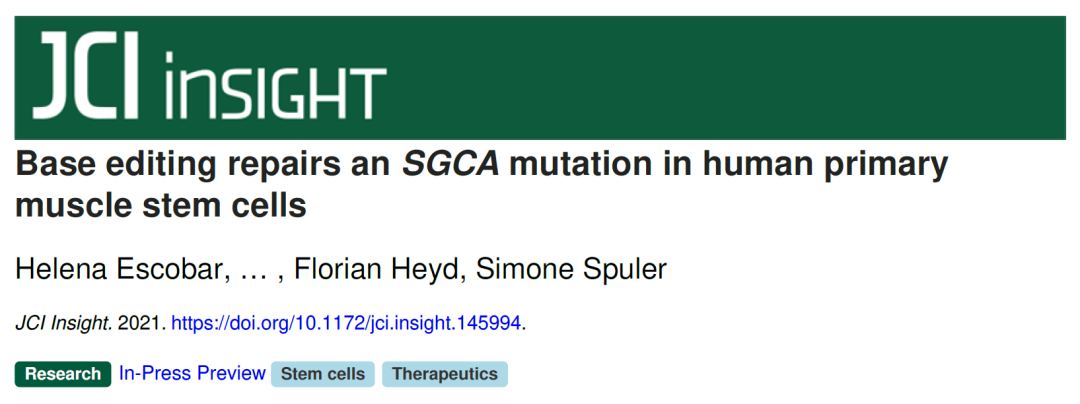
Single-base editing is a highly complex new application of CRISPR-Cas9 gene editing tool. In the classic CRISPR-Cas9 technology, the Cas9 protein cuts both strands of the target DNA, while Cas9 used for single-base editing only replaces a specific base in the target DNA with other bases.
Simply put, the working principle of single-base editing tools is more like tweezers than scissors, so it is very suitable for site-directed mutations of genes. In this study, the research team contacted some families with children suffering from muscular dystrophy. In these families studied, the parents are very healthy and do not know that they have the mutated gene, but the children have inherited a genetic mutation from both parents, so they show muscular dystrophy.
In fact, muscular dystrophy is a collective name for a class of diseases. At present, about 50 different muscular dystrophy have been found. They all have similar phenotypes, but they are different due to different gene mutations.
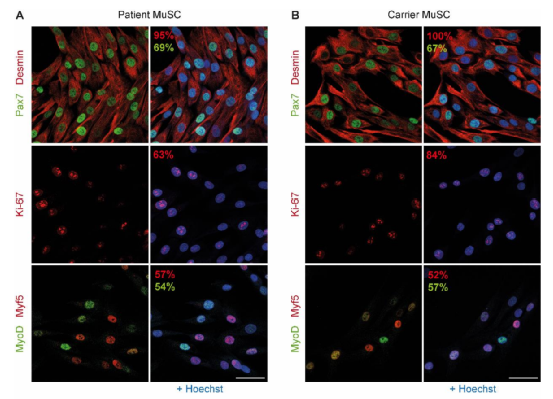
Characteristics of primitive muscle stem cells in patients with muscular dystrophy
After genomic analysis of all patients, the researchers selected a typical patient. This patient’s gene mutation-Limb Girdle Muscular Dystrophy 2-D/R3 is relatively common, and the disease progresses rapidly, and it is in the DNA There is a suitable base editing docking site near the mutation site.
Researchers took a sample of muscle tissue from this 10-year-old patient, isolated muscle stem cells, then cultured and expanded these stem cells in vitro, and used base editing technology to replace the base pairs at the mutation site, and finally the edited Muscle stem cells were injected into the muscles of mice.
Researchers have observed that these muscle stem cells can proliferate in mouse muscles, and most of them develop into muscle fibers. Regarding the results of this study, Professor Simone Spuler, the corresponding author of the study, said excitedly: “With this, we have demonstrated for the first time that it is possible to replace diseased muscle cells with healthy muscle cells!”
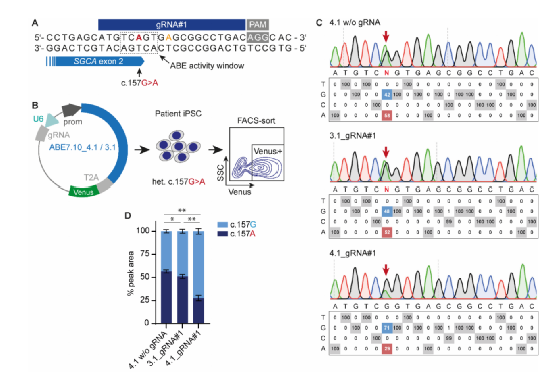
More importantly, single-base editing technology is also a relatively safe method. The research team did not observe any erroneous editing of unintended regions of the genome in the muscle stem cells that had undergone gene repair, that is, there was no off-target effect.
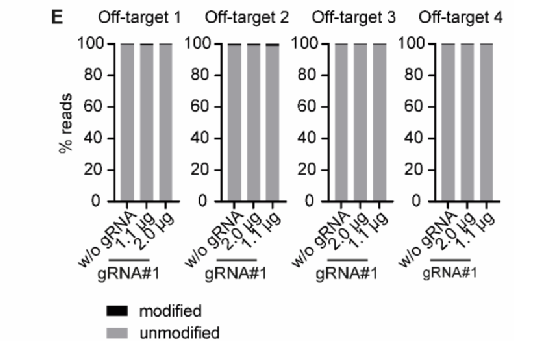
The base editor did not cause obvious off-target effects
The results of this study can be regarded as a milestone in the treatment of muscular dystrophy, but it is only the first step, and further tests are still needed before it can be applied to human treatment.
The next milestone will be to find a way to directly inject the single-base editing system into the patient’s body: Once in the human body, the single-base editor will function for a period of time, editing muscle stem cells, and then quickly decomposing again.
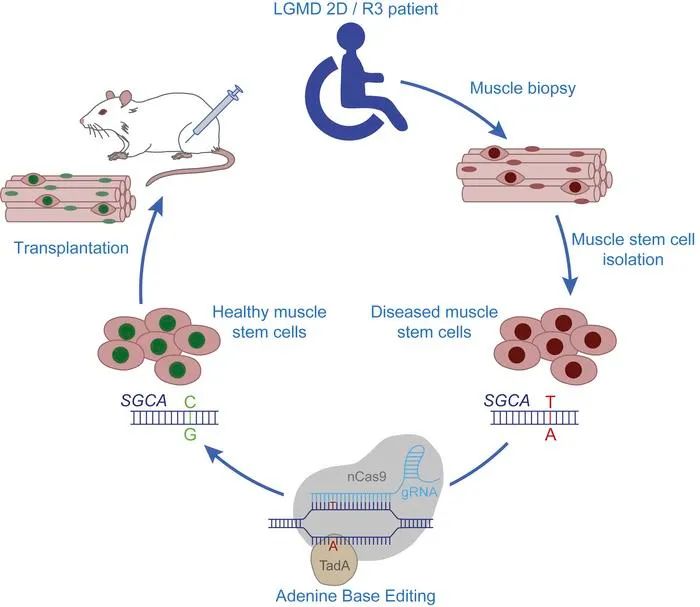
Schematic diagram of this study
The research team hopes to conduct the first experiment on a mouse model as soon as possible. If it can work, the newborns can be tested for genetic mutations in the future, and treatment can be started when there are relatively few cells that need to be edited!
All in all, this study proposes a landmark treatment for muscular dystrophy: Researchers use CRISPR-based single-base editing technology to replace the base pair of the mutation site in the muscle stem cells of patients with muscular dystrophy and return it to Infused into mice, most of these edited muscle stem cells successfully developed into muscle fibers. .
This method of treatment means that, unlike autologous cell therapy, not every patient needs to be treated individually. For every form of muscle therapy, a “tool” is enough to heal muscle wasting before serious injury occurs.
Although there is still a long way to go to truly conquer muscular dystrophy here, it still brings new light to the originally invincible muscular dystrophy.
(source:internet, reference only)
Disclaimer of medicaltrend.org



